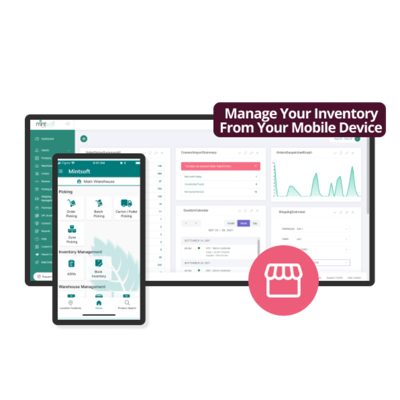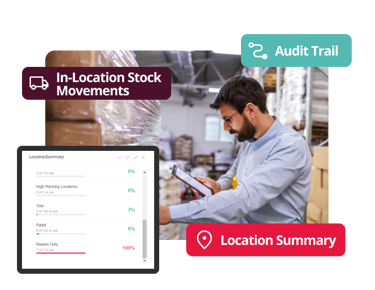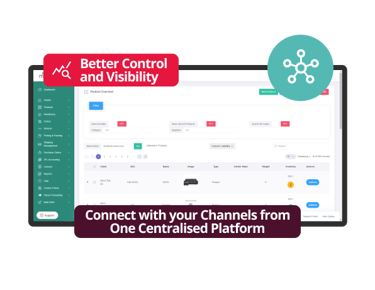The Inventory Management Software for unrivalled accuracy
With our stock control software, you'll always know what you're storing and where to find stock, letting you pick, pack and ship your way to success.

In three years we've grown 300%.
“Our picking accuracy is close to 100% hundred percent and that is all because of system control. You've got to have the right staffing, the right training, the right processes, but without the system, you're going to struggle to a certain degree.”
“Our picking accuracy is approximately 100%. The only time we would have any issues with picking is if the suppliers have sent goods with the wrong barcode.”
Since implementing Mintsoft, The Fulfilment Experts have:
- Grown by 300%
Achieved approximately 100% picking accuracy
Increased order volumes to thousands per day
The inventory management system with 150+ integrations
+
Courier integrations
+
Online shopping platform integrations
+
3PL and Fulfilment customers
+
Online retail customers
What is inventory management software?
An inventory management software system, also known as stock control software, is a programme that helps businesses track and manage their inventory. It automates critical tasks and gives you complete visibility of the entirety of your stock, reducing human errors and ensuring you are never over or understocked. Since stock control software is so crucial to your day to day, it’s essential that you choose software that is reliable, efficient and can easily be tailored to your business needs.
Mintsoft makes inventory management software easy with a range of solutions and features. Through automation, our order management system reduces time spent on manual tasks by monitoring stock availability in real time. Book a personalised demonstration today.
What are the benefits of an inventory management system?
Book a free demo of our stock control software today
Cut time spent on managing inventory
With stock control software, you’ll easily move stock from location to location with simple scanning steps for replenishment or putaway:
- From location
- Product
- Quantity
- New location
You can also adjust stock on-the-fly, directly in location and see a clear audit trail of all historic stock movements.

Never sell out of products again
Stock outages are a business owner's worst nightmare. Not only do they lead to a loss in sales, but you’ll see lower customer satisfaction rates and loyalty levels. With our stock control software, you’ll have better control and visibility of your stock levels across all your channels, in one place.
Mintsoft stock management system automatically keeps track of your inventory at all times, no matter where it is. By connecting with all of your sales and e-commerce channels from one centralised platform, you’ll clearly be able to see when you’re running low on certain products.

Simplified product management
Whether you prefer to use paper or our mobile app, the Mintsoft stock control software allows you to create and schedule batches easily and quickly for straight-forward picking.
The optional Batch Scheduler Module saves a huge amount of admin time by automatically batching up orders based on predefined rules and templates, making products available for picking instantly. Virtually bundle products to be sold together for marketing promotions, without typing up stock in pre-packed kits.
Orders can be batched up at set intervals all throughout the day - or just once per day depending on your preference.

Connect with you current inventory management systems
Our pre-built API integrations allow you to automate manual tasks by integrating with the most popular inventory management systems direct from your Mintsoft dashboard. Allowing you to spend more time focusing on the important stuff.

Mobile barcode picking
Enhance your picking accuracy and speed up inventory tasks by using the Mintsoft app.
The app works seamlessly with the web-based platform to make updates to your inventory and pick orders on the go. With instant sync from the app to the platform, your stock data is always accurate.
100% Pick Accuracy
Relax with the knowledge that your warehouse staff are picking items right the first time. With voice assisted picking commands, product images and user friendly errors, it’s virtually impossible to pick the wrong items.
Multiple Picking Models
Mintsoft’s inventory management system provides various picking models to suit different types of clients and orders. Bulk batch picking, multi-tote and single tote options can be selected and used with ease.
Assign to User or Open Pool
Order picks can be batched up and assigned by warehouse managers to specific pickers. Alternatively they can be assigned to an open pool and left for the first picker to grab and assign to themselves for hassle-free stock management.

Key inventory management software features
Product management features
✓ Product warehouse allocations - if stock is available across multiple warehouses you can assign a priority against each warehouse for stock allocation
✓ Export products to CSV
✓ Low stock alerts - set low stock alerts against each product to get notified when stock levels reach a set amount
✓ Upload products in bulk
✓ Import product information from supported online sales channels
Barcode & data features
✓ Master carton barcodes - scan a carton barcode once to book a larger quantity of stock
✓ Stock flow data report - view transactions relating to a product in, out or stock allocation
✓ Audit trail of product attributes - changes made to main product attributes are logged and displayed under product history tab
✓ Product barcode generation / printing
✓ Dropship products - set products up as dropship products to filter off of orders and automatically send an email to supplier for fulfilling of order
Picking and packing features
✓ Alternate SKU mapping across channels
✓ Add packaging and packing instructions to products
✓ Add linked items or additional products to specific products
✓ Subscription products - create subscription rules for products with length and frequency of the subscription
✓ Product Bundles - create 1 SKU formed of multiple other SKUs (when bundle SKU is ordered it will deduct relevant qty of component SKUs from stock levels
What our customers say
We are particularly impressed with the barcode scanning capabilities offered by Mintsoft which ensures every single order is accurate and has removed all issues relating to inventory management.
Mintsoft’s barcode scanning mobile app makes it virtually impossible to pick the wrong items. We also like that the app means you don’t need to use any branded equipment – you can use the device of your choice which is really handy.
Ben Chidzoy, Co-founder of Fulfillable.
Learn more about Inventory Management Software
Take a look at our guide to inventory management systems in 2025. We cover different types of inventory management, how an inventory management system works, common features and benefits, and how to pick the best inventory management system for your business.
Alternatively learn about our inventory warehouse software that ensures streamlined and efficient warehouse processes.

Inventory management software FAQs
Why is inventory management software important for every business?
At some point every business handles stock, from large retailers to small independent businesses. An inventory management software helps keep products fully organised from entry to exit of the business, increasing accuracy and preventing human error, as well as potential loss of revenue. A modern stock control software is the key factor that keeps businesses from being burdened with traditional and outdated inventory management.
How does inventory management software work?
An inventory management system is a specialist software that tracks the stock coming in and out of the door via customer purchases, as well as how much stock remains with the business and how it's organised. The software also analyses the data taken from the stock management system and gives recommendations on how to streamline operations further. Warehouse managers and staff will have a real-time picture of the current inventory, as well as what will happen in the future.
What’re the benefits of inventory management software?
There are many benefits of inventory management software, however your business will primarily see increased efficiency, reduced costs savings and a better customer experience. By streamlining and automating stock control processes with inventory software, there will be better visibility of warehouse organisation, less stock outages and increased productivity from staff. Ultimately getting stock out to customers faster, with less errors




